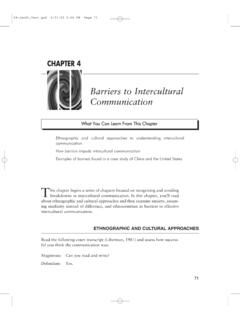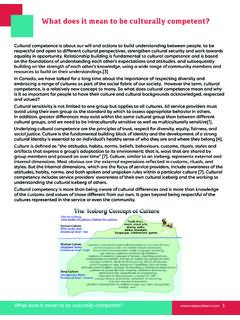Transcription of Stumbling Blocks in Intercultural Communication
1 Stumbling Blocks in Intercultural Communication LARAY M. BARNA. Why is it that contact with persons from other cultures so often is frustrating and fraught with misunderstanding? Good intentions, the use of what one considers to be a friendly approach, and even the possibility of mutual benefits don't seem to be sufficient to many people's surprise. A worse scenario is when rejection occurs just because the group to which a person belongs is "different." It's appropriate at this time of major changes in the international scene to take a hard look at some of the reasons for this. New proximity and new types of relationships are presenting Communication challenges that few people are ready to meet. The Six Stumbling Blocks I. Assumption of Similarities One answer to the question of why misunderstanding and or rejection occurs is that many people naively assume there are sufficient similarities among peoples of the world to make Communication easy'.
2 They' expect that simply being human, having common requirements of food, shelter, security, and so on, makes everyone alike. Unfortunately they overlook the act that the forms of adaptation to these common biological and social needs and the values, beliefs, and attitudes surrounding them are vastly different from culture to culture. The biological commonalities are not much help when it comes to Communication , where we need to exchange ideas and information, find way's to live and work together, or just make the kind of impression we want to make. Another reason many people are lured into thinking that "people are people" is that it reduces the discomfort of dealing with difference. If someone acts or looks "strange". (different from them), it's then possible to evaluate this as "wrong" and treat everyone ethnocentrically The assumption of similarity does not often extend to the expectation of a common verbal language but it does interfere with caution in decoding nonverbal symbols, signs, and signals.
3 No cross-cultural studies have proven the existence of a common nonverbal language except those in support of Darwin's theory that facial expressions are universal. Ekman (1976) found that "the particular visible pattern on the face, the combination of muscles contracted for anger, fear, surprise, sadness, disgust, happiness {and probably also for interest) is the same for all members of our species" (pp. 19-20). This seems helpful until it is realized that a person's cultural upbringing determines whether or not the emotion will be displayed or suppressed, as well as on which occasion and to what degree (Ekman & Friesen, 1969, p. 1). The situations that bring about the emotional feeling also differ from culture to culture, for example the death of a loved one may be a cause for joy, sorrow or some other emotion, depending upon the accepted cultural belief.}
4 Since there seem to be no universals or "human nature" that can be used as a basis for automatic understanding, we must treat each encounter as an individual case, searching for whatever perceptions and Communication means are held in common and proceed from there. This is summarized by Vin The Do: "If we realize that we are all culture bound and culturally modified, we will accept the fact that, being unlike, we do not really know what someone else 'is.' This is another way to view the 'people are people' idea. We now have to find a way to sort out the cultural modifiers in each separate encounter to find similarity.". Persons from the United States seem to hold this assumption of similarity m ore strongly than some other cultures. The Japanese for example, have the reverse belief that they are distinctively different from the rest of the world.
5 This notion brings Intercultural Communication problems of its own. Expecting no similarities they work hard to figure out the foreign stranger but do not expect foreigners to be able to understand them. This results in exclusionary attitudes and only passive efforts toward mutual understanding (Tai. 1986, ). As Western trappings permeate more and more of the world the illusion of similarity increases. A look-alike facade deceives representatives from contrasting cultures when each wears Western dress, speaks English, and uses similar greeting rituals. It is like assuming that New York, Tokyo, and Tehran are all alike because each has the appearance of a modern city. But without being alert to possible underlying differences and the need to learn new rules for functioning, persons going from one city to the other will be in immediate trouble, even when taking on such simple roles as pedestrian or driver.
6 Also, unless a foreigner expects subtle differences it will take a long time of noninsulated living in a new culture (not in an enclave of his or her own kind) before he or she can be jarred into a new perceptual and nonevaluative thinking. The confidence that comes with the myth of similarity is much stronger than with the assumption of differences, the latter requiring tentative assumptions and behaviors and a willingness to accept the anxiety of "not knowing." Only with the assumption of differences, however, can reactions and interpretations be adjusted to fit "what's happening." Without it someone is likely to misread signs and symbols and judge the scene ethnocentrically. The Stumbling block of assumed similarity is a troublem, as one English learner expressed it, not only for the foreigner but for the people in the host country (United States or any other) with whom the international visitor comes into contact.
7 The native inhabitants are likely to be lulled into the expectation that, since the foreign person is dressed appropriately and speaks some of the language, he or she will also have similar nonverbal codes, thoughts, and feelings. In the United States nodding, smiling, and affirmative comments from a foreigner will probably be confidently interpreted by straightforward, friendly Americans as meaning that they have informed, helped, and pleased the newcomer. It is likely, however, that the foreigner actually understood very little of the verbal and nonverbal content and was merely indicating polite interest or trying not to embarrass himself or herself or the host with verbalized questions. The conversation may even have confirmed a stereotype that Americans are insensitive and ethnocentric. In instances like this, parties seldom compare impressions and correct misinterpretations.
8 One place where opportunities for achieving insights does occur is in an Intercultural Communication classroom. Here, for example, students often complain that international student members of a discussion or project group seem uncooperative or uninterested. One person who had been thus judged offered the following explanation: I was surrounded by Americans with whom I couldn't follow their tempo of discussion half of the time. I have difficulty to listen and speak, but also with the way they handle the group. I felt uncomfortable because sometimes they believe their opinion strongly. I had been very serious about the whole subject but I was afraid I would say something wrong. I had the idea but not the words. The classroom is also a good place to test whether one common nonverbal behavior, the smile, is actually the universal sign people assume it to be.
9 The following enlightening comments came from international students newly arrived in the United States. Japanese student: On my way to and from school I have received a smile by non- acquaintance American girls several times. I have finally learned they have no interest for me, it means only a kind of greeting to a foreigner. If someone smiles at a stranger in Japan, especially a girl, she can assume he is either a sexual maniac or an impolite person. Korean student: An American visited me in my country for one week. His inference was that people in Korea are not very friendly because they didn't smile or want to talk with foreign people. Most Korean people take time to get to be friendly with people. We never talk or smile at strangers. Arabic student: When I walked around the campus my first day many people smiled at me.
10 I was very embarrassed and rushed to the men's room to see if I had made a mistake with my clothes. But I could find nothing for them to smile at. Now I am used to all the smiles. Vietnamese student: The reason why certain foreigners may think that Americans are superficial - and they are, some Americans even recognize this - is that they talk and smile too much. For people who come from placid cultures where nonverbal language is more used, and where a silence, a smile, a glance have their own meaning, it is true that Americans speak a lot. The superficiality of Americans can also be detected in their relations with others. Their friendships are, most of the time, so ephemeral compared to the friendships we have at home. Americans make friends very easily and leave their friends almost as quickly, while in my country it takes a long time to-find out a possible friend and then she becomes your friend with a very strong sense of the term.

![Palladium-Catalyzed C[bond]N and C[bond]O …](/cache/preview/4/3/9/c/6/e/9/3/thumb-439c6e93d844ff459e84bd8810193673.jpg)







